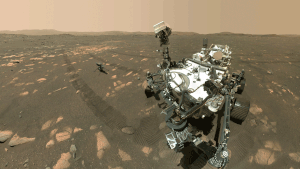
Back مارس 2020 (مسبار فضائي) Arabic মার্স ২০২০ Bengali/Bangla Mars 2020 BS Mars 2020 Catalan Mars 2020 Czech Mars 2020 German Mars 2020 Greek Mars 2020 Esperanto Mars 2020 Spanish Mars 2020 Estonian
 | |
| Mission type | Mars exploration |
|---|---|
| Operator | |
| COSPAR ID | 2020-052A |
| SATCAT no. | 45983 |
| Mission duration | 1 Mars year (668 sols, 687 Earth days) (planned) Perseverance: 3 years, 2 months and 27 days (since landing) Ingenuity: 2 years, 9 months and 22 days (final) |
| Spacecraft properties | |
| Spacecraft | Perseverance Ingenuity |
| Launch mass | 3,649 kg (8,045 lb) |
| Start of mission | |
| Launch date | 30 July 2020, 11:50:00 UTC |
| Rocket | Atlas V 541 (AV-088) |
| Launch site | Cape Canaveral, SLC-41 |
| Contractor | United Launch Alliance |
| Mars rover | |
| Landing date | 18 February 2021 |
| Landing site | Octavia E. Butler Landing, Jezero 18°26′41″N 77°27′03″E / 18.4447°N 77.4508°E |
| Distance driven | 23.73 km (14.75 mi) as of 3 January 2024[update] [1] |
| Mars aircraft | |
| Landing date | 3 April 2021 (Deployed from Perseverance)[2] |
| Landing site | Helipad at Wright Brothers Field near Octavia E. Butler Landing, Jezero[3] 18°26′41″N 77°27′04″E / 18.44486°N 77.45102°E |
| Distance flown | 17.242 km (10.714 mi) in 72 flights[1] |
  NASA and JPL insignias | |
Mars 2020 is a NASA mission that includes the rover Perseverance, the now-retired small robotic helicopter Ingenuity, and associated delivery systems, as part of the Mars Exploration Program. Mars 2020 was launched on an Atlas V rocket at 11:50:01 UTC on July 30, 2020,[4] and landed in the Martian crater Jezero on February 18, 2021, with confirmation received at 20:55 UTC.[5] On March 5, 2021, NASA named the landing site Octavia E. Butler Landing.[6] As of 15 May 2024, Perseverance has been on Mars for 1150 sols (1182 total days; 3 years, 87 days).[7][8][9][10][11] Ingenuity operated on Mars for 1042 sols (1071 total days; 1 year, 341 days) before sustaining serious damage to its rotor blades, possibly all four, causing NASA to retire the craft on January 25, 2024.[12][13]
Perseverance is investigating an astrobiologically relevant ancient environment on Mars for its surface geological processes and history, and assessing its past habitability, the possibility of past life on Mars, and the potential for preservation of biosignatures within accessible geological materials.[14][15] It will cache sample containers along its route for retrieval by a potential future Mars sample-return mission.[15][16][17] The Mars 2020 mission was announced by NASA in December 2012 at the fall meeting of the American Geophysical Union in San Francisco. Perseverance's design is derived from the rover Curiosity, and it uses many components already fabricated and tested in addition to new scientific instruments and a core drill.[18] The rover also employs nineteen cameras and two microphones,[19] allowing for the audio recording of the Martian environment. On April 30, 2021, Perseverance became the first spacecraft to hear and record another spacecraft, the Ingenuity helicopter, on another planet.
The launch of Mars 2020 was the third of three space missions sent toward Mars during the July 2020 Mars launch window, with missions also launched by the national space agencies of the United Arab Emirates (the Emirates Mars Mission with the orbiter Hope on July 19, 2020) and China (the Tianwen-1 mission on July 23, 2020, with an orbiter, deployable and remote cameras, lander, and Zhurong rover).
- ^ a b "Where is Perseverance?". Mars 2020 Mission Perseverance Rover. NASA. Retrieved August 20, 2022.
- ^ "NASA's Mars Helicopter Survives First Cold Martian Night on Its Own". Nasa Mars Website.
 This article incorporates text from this source, which is in the public domain.
This article incorporates text from this source, which is in the public domain.
- ^ "NASA to Attempt First Controlled Flight on Mars As Soon As Monday". April 17, 2021.
 This article incorporates text from this source, which is in the public domain.
This article incorporates text from this source, which is in the public domain.
- ^ "NASA, ULA Launch Mars 2020 Perseverance Rover Mission to Red Planet". NASA. July 30, 2020. Retrieved August 2, 2020.
 This article incorporates text from this source, which is in the public domain.
This article incorporates text from this source, which is in the public domain.
- ^ "Touchdown! NASA's Mars Perseverance Rover Safely Lands on Red Planet". NASA's Mars Exploration Program. February 18, 2021. Retrieved February 19, 2021.
 This article incorporates text from this source, which is in the public domain.
This article incorporates text from this source, which is in the public domain.
- ^ "Welcome to 'Octavia E. Butler Landing'". NASA. March 5, 2021. Retrieved March 5, 2021.
 This article incorporates text from this source, which is in the public domain.
This article incorporates text from this source, which is in the public domain.
- ^ Strickland, Ashley (April 15, 2021). "Why Mars? The fascination with exploring the red planet". CNN. Retrieved March 19, 2023.
- ^ "Mars | Facts, Surface, Moons, Temperature, & Atmosphere | Britannica". www.britannica.com. Retrieved March 19, 2023.
- ^ Ben Turner (July 16, 2021). "Some evidence of ancient Martian life has mysteriously vanished, NASA finds". livescience.com. Retrieved March 19, 2023.
- ^ mars.nasa.gov. "Mars Technologies - NASA". mars.nasa.gov. Retrieved March 19, 2023.
- ^ Chang, Kenneth (September 15, 2022). "Life on Mars? This Could Be the Place NASA's Rover Helps Us Find It". The New York Times. ISSN 0362-4331. Retrieved March 19, 2023.
- ^ "After Three Years on Mars, NASA's Ingenuity Helicopter Mission Ends". Jet Propulsion Laboratory.
- ^ NASA Science Live: Ingenuity Mars Helicopter Tribute & Legacy, retrieved February 1, 2024
- ^ Chang, Alicia (July 9, 2013). "Panel: Next Mars rover should gather rocks, soil". Associated Press. Retrieved July 12, 2013.
- ^ a b Schulte, Mitch (December 20, 2012). "Call for Letters of Application for Membership on the Science Definition Team for the 2020 Mars Science Rover" (PDF). NASA. NNH13ZDA003L.
 This article incorporates text from this source, which is in the public domain.
This article incorporates text from this source, which is in the public domain.
- ^ Cite error: The named reference
MPPGwas invoked but never defined (see the help page). - ^ Cite error: The named reference
Moskowitzwas invoked but never defined (see the help page). - ^ Amos, Jonathan (December 4, 2012). "NASA to send new rover to Mars in 2020". BBC News. Retrieved December 5, 2012.
- ^ February 2021, Mike Wall 17 (February 17, 2021). "The sounds of Mars: NASA's Perseverance rover will put ears on the Red Planet for the 1st time". Space.com. Retrieved February 18, 2021.
{{cite web}}: CS1 maint: numeric names: authors list (link)
© MMXXIII Rich X Search. We shall prevail. All rights reserved. Rich X Search